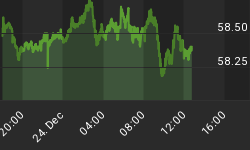The important new information in the Commerce Department's third guess at last year's fourthquarter GDP was its first guess at the same quarter's corporate profits. Commerce guessed low. Before-tax profits adjusted for inventory valuation and capital consumption turned negative sequentially, submerging 0.30% (not annualized) in Q4:2006. In fact, after a Q1:2006 surge of 12.60%, corporate profit growth was downright anemic in the last three quarters of 2006, as was real GDP growth (see Chart 1 below). With volume growth slowing and labor costs rising, it is no wonder that profits growth is now struggling. It is doubtful things will turn around soon unless Circuit City's plan to effectively cut the salaries of many of its employees becomes the norm.
Chart 1
With profit growth slowing sequentially last year, why do you think the stock market performed as well as it did? Do you think it might have had something to do with the massive "retirement" of corporate equities? With profit growth slowing, how did corporations fund these massive buybacks? By stepping up their borrowing relative to their capital expenditures, of course (see Chart 2). Current equity bulls better hope that "liquidity" continues in the credit markets so that corporations can continue to retire their equities.
Chart 2
The fourth-quarter contraction in corporate profits would have been worse had it not been for Wall Street's profits and profits of U.S. corporations earned abroad. Profits of domestic nonfinancial corporations declined 6.63% in the fourth quarter while profits of domestic financial corporations and profits earned from abroad increased 4.32% and 15.90%, respectively. The creation of mortgage-related financial instruments has been a money machine for Wall Street in this expansion. Now that mortgage credit growth is in a steep decline, Wall Street will have to find another money machine. I have complete confidence it will.
The revisions to fourth-quarter real GDP were minor - a little less private fixed investment, including both residential and nonresidential, fewer imports and a little more inventory building. Domestic demand, excluding inventories, grew at an annualized rate of only 1.92% in the fourth quarter and averaged a puny 1.8% in the three quarters ended Q4:2006 (see Chart 3). The first quarter is not going to be any better, probably worse! Details of the GDP revisions are shown in the table below.
Chart 3

















